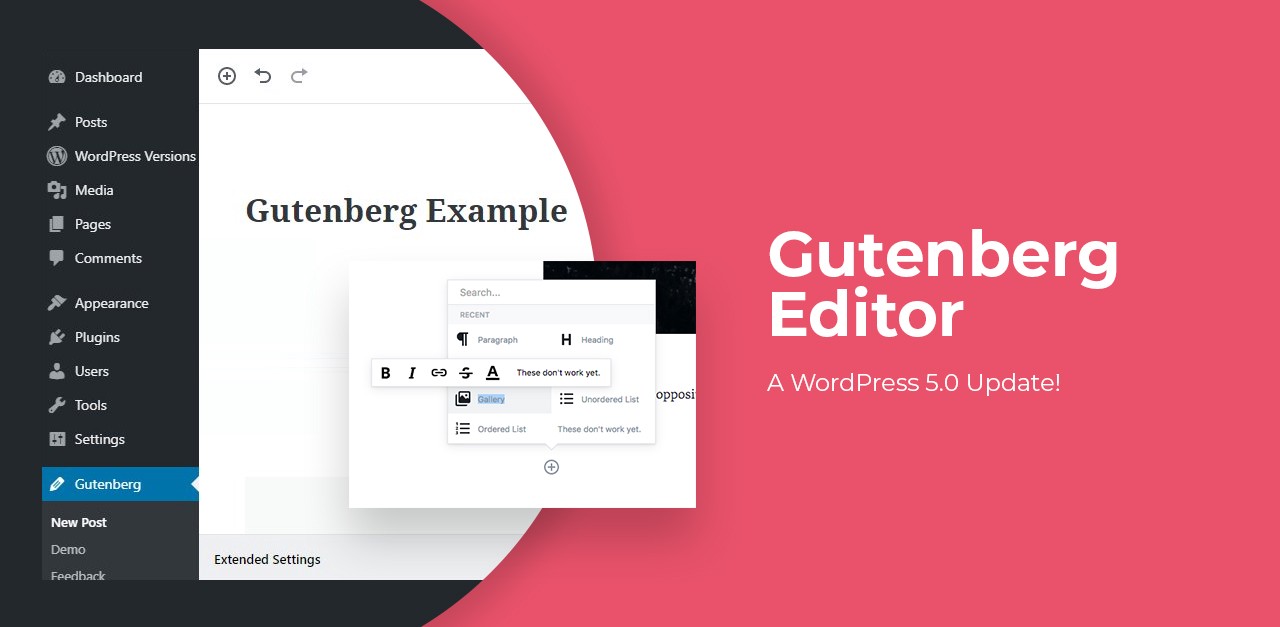
As you’ve probably heard, WordPress 5.0 was released on 27 November 2018. So what is changing? What’s new ? We explain everything in this article, without forgetting, of course, the biggest change: the new publisher Gutenberg.
You have two possibilities to test WordPress 5.0, they are:
- Test the WordPress Beta Tester plugin
- Download the Beta version to test it
What’s new in this new version of WordPress?

The main changes concern the WYSIWYG text editor. Indeed, the latter has been replaced by the publisher Gutenberg. Among the main notable changes, there are:
- The addition of a permalink panel on the sidebar of the document, allowing a faster search.
- The editing blocks of your texts will now take the full width of the editor.
- Image management in the Media section has been improved for a better user experience.
- Support for PHP7.3: Indeed, a bug has been fixed and it is now possible to install WordPress 5.0 on the PHP7.3 version.
WordPress 5.0 and the arrival of Gutenberg
This is a small revolution for WordPress. The idea of this plugin is to be able to visualize the changes made to its page or its article in real time. In addition, the layout through blocks allows anyone, even beginners to embark on the creation of their website.
Gutenberg is a true website builder just like Visual Composer. However, this plugin is not intended to change the course of WordPress history and to replace the Page Builder plugins for the moment.
Gutenberg can create blocks (Title, paragraphs, images) to facilitate access to this software for beginners. In addition, this makes it possible to adapt to the future of website creation. The personalization of the content according to the visitor. Currently, it is impossible to create different content depending on the profile of each of your visitors.
If, in the months to come, Gutenberg keeps its promise and allows to create blocks of reusable content as desired by the founders, this may indeed be a small revolution in the field. Indeed, this will allow the establishment of very relevant content that can evolve according to the interests of each.
Which modules are pre-installed on Gutenberg?
In its current version, Gutenberg has five types of content blocks that are:
- Common: These are the basic blocks (Titles, paragraphs, and pictures).
- Formatting: These are the formats in which you will be able to write your various contents (Classic, HTML, Code source, preformatted text).
- Layout: These blocks will allow you to heal the layout of your articles using separators, columns, buttons.
- Widget: It is now possible to integrate the Widget of your choice directly in the article.
- Embed: this is content from other platforms such as Youtube or Twitter for example.
Does Gutenberg have pre-formatted templates like Visual Composer?
Gutenberg is currently replacing the present editor. It is not yet considered a builder of web pages, but for the moment replaces the classic editor. This is the reason why the latter does not yet have preformatted templates. However, you can create your own reusable blocks for other items.
Is it possible to switch from Classic to Gutenberg?
It is indeed possible to switch from the current classic editor to Gutenberg without the present pages being modified. You can also easily return to the classic editor by disabling the Gutenberg plugin. However, if you use HTML tags in your regular editor, you may have some bugs in the layout. Indeed, the HTML and Code Source blocks available on Gutenberg are not yet 100% reliable but this should be updated very soon.
How to update my WordPress version?
The WordPress 5.0 version mainly focuses on the change of editor and the default setting of Gutenberg instead of the classic editor. Therefore, if you are using a site with a recent WordPress version, the theme used should be compatible with the new version of WordPress. However, it is best to contact the developers of the theme in question to ensure the compatibility of their themes.
However, there should be no problem as Gutenberg does not change the content of an existing site.
On the other hand, some plugins such as Yoast SEO or other goods may no longer work optimally due to the implementation of block content. The developers of these most popular plugins are already working on new versions that will allow a perfect integration with Gutenberg.
If you want to take the plunge and update your WordPress version to 5.0, it is still advisable to make a backup of your website and database before. Indeed, each WordPress site being different, it is possible that some bugs appear after the update. It is, therefore, necessary to be able to restore the latter if necessary.
Conclusion
You now know everything about this new update of WordPress and its publisher Gutenberg! All you have to do is update your WordPress site. If this article was useful to you, do not hesitate to share it and give us your opinion on this new version of WordPress 5.0

Comments are closed.